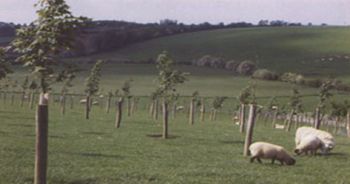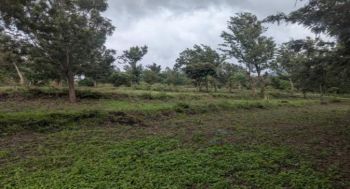
News
Trees on the Farm: Restoring Land with Agroforestry as a Nature-Based Solution
Posted on behalf of: Dr Cynthia Olumba, Cranfield University - Work Package 1 - REAL NbS Project
Last updated: Wednesday, 6 August 2025

An example of Silvopasture system - photo credit Prof Jane Rickson, Cranfield University.

An agrosilviculture system at one of the REAL NbS project’s experimental sites in Tanzania - photo credit NM-AIST team, Tanzania.
What is Agroforestry?
Imagine a maize field bordered with fast-growing acacia trees. Or coffee plants thriving under the protective shade of banana trees. Or livestock grazing between fruit-bearing trees that feed families and the soil all at once. This is the promise of agroforestry: a nature-based solution gaining momentum as a key strategy to restore degraded lands, enhance biodiversity, boost soil fertility, and help farmers adapt to climate change.
Agroforestry is the intentional integration of trees and shrubs alongside crops and/or livestock on the same piece of land. Unlike conventional agriculture, which often separates trees from farmlands, agroforestry brings them together in ways that benefit both the farmland and the people who depend on it. This can take many forms:
- Agrosilviculture: Planting trees with crops to enrich soil, support beneficial insects, and provide shelter from wind and rain.
- Silvopasture: Combining trees/shrubs and livestock to provide shade and improve soil and grass health.
- Agrosilvopasture: Integrating trees, crops, and livestock into one mutually supportive system.
Agroforestry in the REAL NbS Project
Agroforestry and tree planting are among the NbS co-selected during the inception workshops, held in Tanzania and Ethiopia in the autumn of 2024. These solutions are now being tested within the REAL NbS project. In Tanzania, some farmers are maintaining existing trees on their fields, while in Ethiopia, others are planting and managing young trees and shrubs. With support from the project team, these farmers are monitoring the effectiveness of these practices in reducing land degradation.
Why Agroforestry Makes a Difference
Agroforestry helps make landscapes greener to improve yields and enhance biodiversity, leading to more sustainable land use. Here’s how:
- Soil Protection: Tree roots hold soil together, reducing losses of soil and nutrients.
- Water Retention: Tree canopies collect rainwater and reduce evaporation. Tree roots improve water infiltration: Crops are buffered against drought.
- Biodiversity: Trees and shrubs are habitats for birds, insects, and pollinators, boosting farm health.
- Climate Resilience: Trees absorb and store carbon and moderate microclimates, protecting crops from extreme heat.
- Higher Yields Over Time: Improved soil and microclimates can lead to higher, more reliable crop yields.
- Diversified Income: Trees provide fruits, nuts, timber, and firewood — diversifying farm income and food sources.
So next time you see a tree in a field, think twice. It might not be in the way — it might be exactly what that farm, and our planet, needs.
But What Are the Challenges?
Agroforestry brings many benefits, but it’s not without its difficulties. Here are some key ones to consider:
- Slow Establishment: Trees and shrubs can take years to grow before they start delivering benefits.
- High Maintenance: Managing tree pruning and maintaining growth requires significant labour, sometimes up to 52% more work than conventional farming.
- Trade-offs in Land Use: Trees and shrubs take up space, sometimes reducing the land available for cropping. Yield gains must compensate for this loss.
- Pest & Fire Risks: Trees can attract pests like birds, snails, and rodents, and increase fire risks in dry seasons.
- Soil Compatibility Issues: On acidic soils, pruning may not decompose well, reducing nutrient cycling benefits.
Agroforestry isn’t a silver bullet, but when thoughtfully planned, it helps build healthier farms and landscapes. Like any agricultural system, it requires care, adaptation, and long-term commitment.
Further information: https://www.sussex.ac.uk/research/projects/land-degradation-nature-based-solutions/

